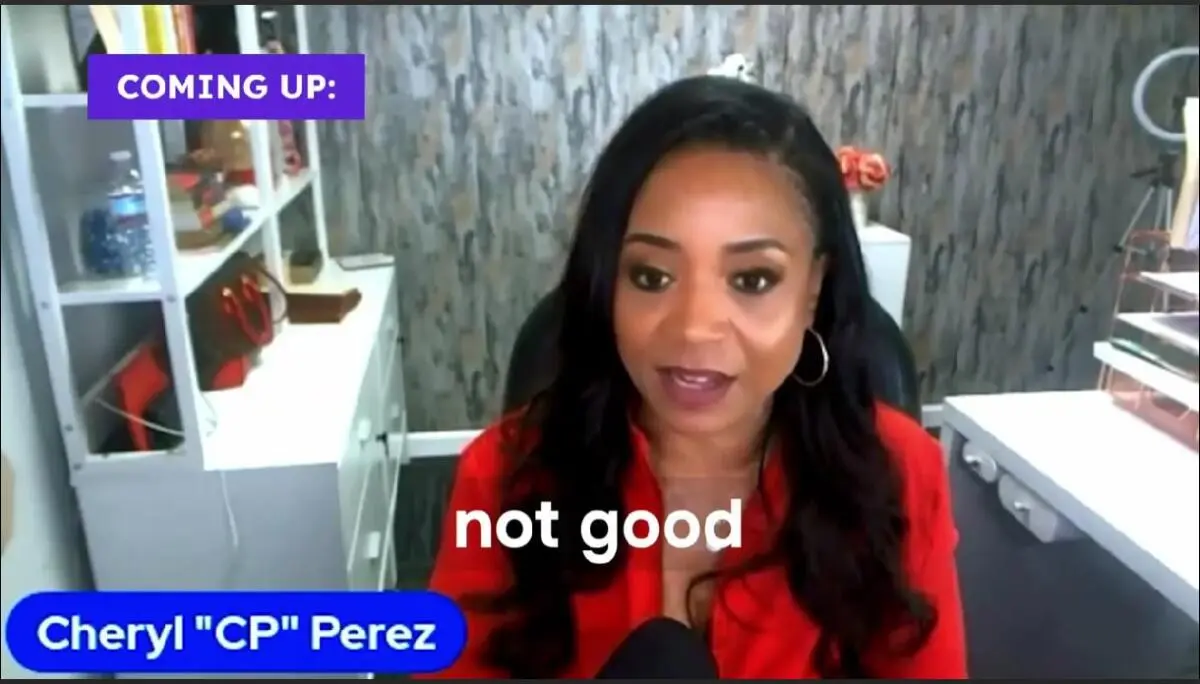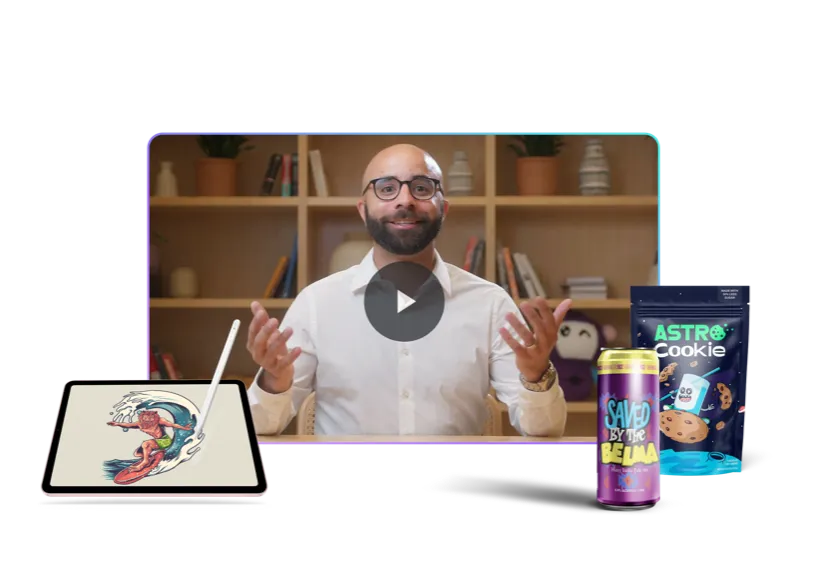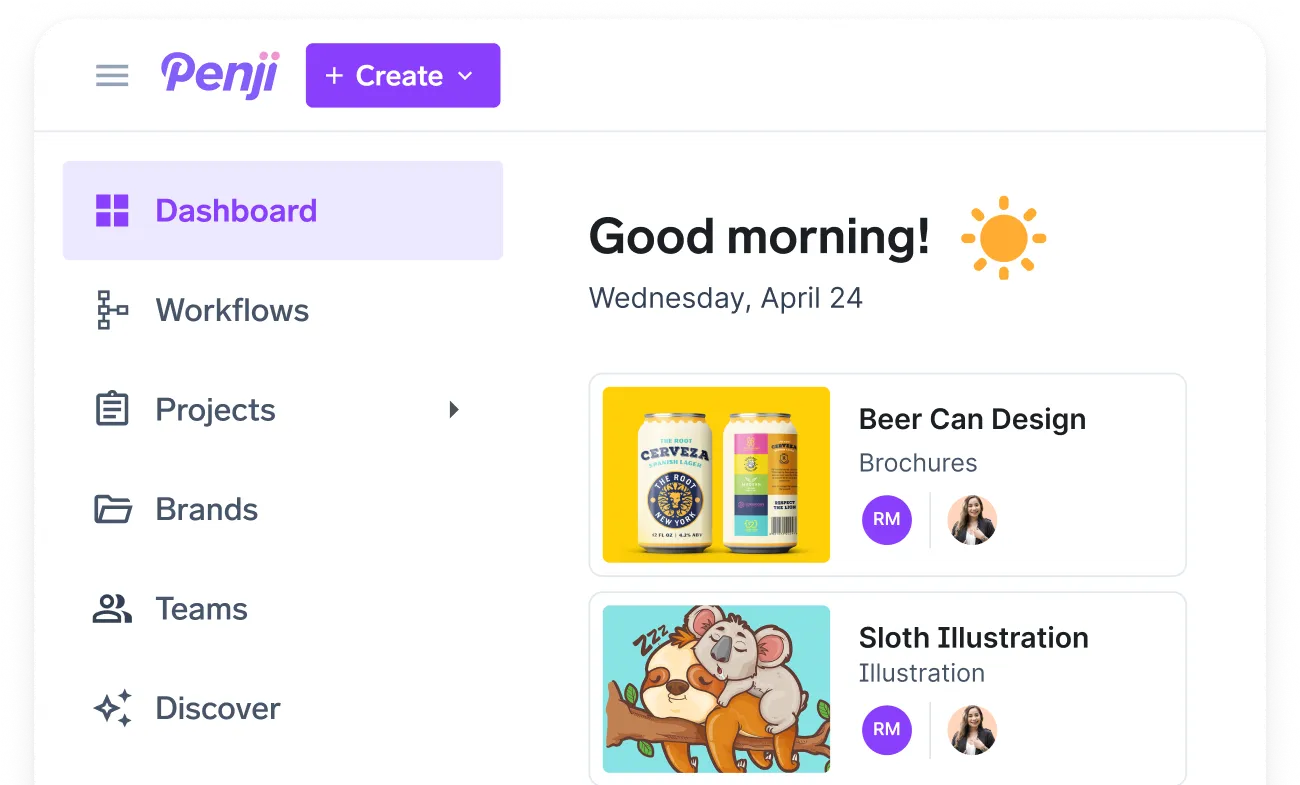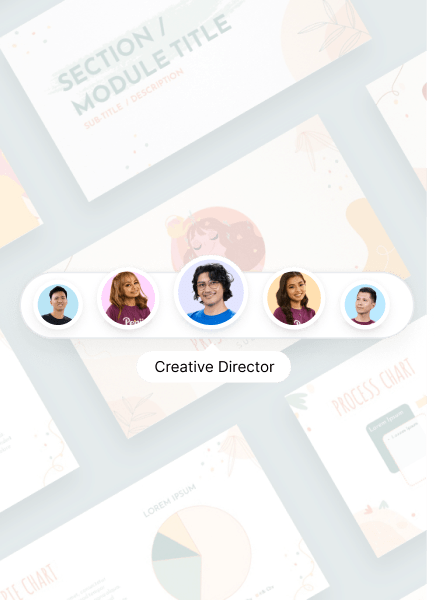
Interview Introduction
Speaker 1: Why are you interviewing? Am I not good enough for the role that I’ve been doing for six months? And you know, he looked at me and said, you know, I think that you could do a great job, but you’re just not bitchy enough for the role. And there was another woman who would have also been on the management team. There were only two of us who were kind of functioning in this role. And he said, and honestly, I just don’t think that the board would do well with two women in positions of power. And it was like my glass ceiling came crashing down, right? It was like, first of all, I’m not bitchy enough. And there’s only enough room for one woman in.
Speaker 2: Leadership in this company.
Penji Advertisement
Speaker 3: This podcast is brought to you by Penji. Penji is a creative subscription service that gives you access to pre-vetted agency trained creatives from all over the world. From graphic design to illustrations to social media management and web development, it’s all included for one monthly price. It’s time to say goodbye to the hassle of searching for top notch creative talent. With Penji, you get quality and consistency delivered right to your inbox every day, carefully crafted for you by humans. So meet your new creative team today. Head over to Penji.co for more. And enter the coupon code located within the podcast shownotes.
Guest Introduction
Speaker 4: Hello everybody. Welcome to the first 100 podcast. This is where we explore the journey of entrepreneur, business owners, agency leaders and so many more people as they share with us the strategies, the challenges and the triumphs that have led them to secure those first 100 customers. I’m your host, Daniela, and I’m Penji’s partnership coordinator. Okay. I’m joined here with a very special guest, Cheryl Perez. Hi, Cheryl. How are.
Cheryl Perez (CP): you? Hi, how are you?
Daniela (D): It’s very good to have you. Very excited to have you on the podcast today. For anybody who is just new to this, who is getting to know you, who doesn’t know who you are, can you give us a little bit of a quick intro and a rundown of you?
CP: Absolutely. I am so excited to be here with everyone today. I am Cheryl C.P. Perez, all of my peeps. My folks call me S.P., so please call me S.P. if you so much desire. I actually am a 25 year entrepreneur that focuses on consulting work as an operations consultant for small businesses and nonprofits. And a few years ago, I actually added what my favorite component is to my business, which is coaching for startup and growth stage entrepreneurs. I focus on helping folks get their structures and their strategies, their systems and processes and their squads developed and built out so that they can ultimately grow their dream businesses and get to that life of freedom that we all start our businesses for. To have the processes and the systems and everything in place to be able to grow big empires but also relax and enjoy life. And it’s it’s my first passion and love. And I’m also the host of my YouTube channel C TV, which right now I think that we’re 30,000 subscribers on a weekly basis. I provide free training around structure, strategy systems and squads to grow sales and start up entrepreneurs. And I’m excited to be here with you guys today.
Journey into Non-Profits and Small Businesses
D: Excited to have you. That’s a pretty big raspberry you’ve got. And, you know, very interesting. I actually wanted to ask you some questions regarding your job. And this is one that actually this is just out of my curiosity, but what made you want to go into non-profits and small businesses specifically?
CP: You know, as an entrepreneur, when you are first starting my very first entrepreneurial experience I didn’t even recognize was an entrepreneurial experience. I went to college, thought I was going to be a lawyer, finished school a little early, and decided to do an externship at the law school that I was accepted to, worked with a student who had graduated and a big law firm in D.C. and absolutely hated it. And at that point I said, I do not want to be. And the big attorney, corporate attorney, you know, doing billable hours. And so it caused me to have to reflect on where I was going. And I decided, you know, I think I’m going to try out graduate school in business. I’ve always enjoyed my business classes because it was marketing and communications was my major. And I always had a little bit of an entrepreneurial spark. I mean, I grew up really poor, my family, I was like a first gen student and my family, my mom and dad didn’t have a whole lot of money to support me. And so I did all kinds of like businesses on the side in order to make money.
Realizing Entrepreneurship
D: That’s incredible. I mean, it’s very, I think, very interesting that you were kind of just, you know, life just took you where it took you and you it didn’t even recognize it at first. And then you sort of had to realize like, oh, actually what I’m doing right now is entrepreneurship. Yeah.
CP: Yeah, exactly. I think that I’m a big believer in the universe and that nothing really happens for no reason at all. And I think that no matter how hard I fought it and thought that I was supposed to go in a direction, every single circumstance and situation that occurred in my left kept leading me back to entrepreneurship. It was really insane. Looking back over the years, I’ve been like, Oh my God, you couldn’t escape it. There was just no way, because that was obviously what I was intended to do. That was it is so much my purpose. It is what fulfills me entrepreneurship in general. And I love doing what I do. But I didn’t even realize it then that the universe was going to say no. You keep staring off the path. We’re going to put you back. We’re going to put you back on it to where you’re supposed to end up. Yeah.
D: That’s incredible. Yeah, well, that’s very good. I mean, congratulations, I think. And a lot of people have that dream of being able to have that established business and be able to sort of be their own bosses, you know, with working for the man can be really stressful for almost everyone.
CP: It can be a toxic relationship. I agree.
Corporate Experiences and Entrepreneurial Shift
CP: And so you continue to endure as you’ve kind of alluded to, this toxic relationship sometimes just so that you can kind of get going and get started. So my business was initially before I realized it was a business, it was my full time thing because I was a freelancer and then I even fought it even more. And after my contract ended, instead of pursuing more independent contracts, I was like, okay, well, that was great. Now it’s time for me to go work for somebody else. And so I did. I worked in corporate America, but always had what I was doing overseas as an unknown business, as a side hustle. And I thought originally that it was just going to stay a side hustle. I’m like, Oh, I can make extra money, I can build a thing. I’m supposed to work in corporate America. And there were so many moments in my corporate life that were pivotal and screaming at me, Girl, this side hustle thing is just temporary. And I think that one of the first moments was, you know, I was working in sales and marketing at a large corporation, and I was working my butt off because I thought I wanted to get this promotion to run run the team. And the person who was in that position, I was just kind of waiting and biding my time for when they were going to leave. You know, that moment where you’re like, Oh my God, please retire. And I was waiting. And they finally did. And the organization actually gave me the interim title No More Money for six Months. And I thought, it’s okay, I’m going to do my due diligence. I’m going to work my way up. This is this corporate ladder. And I ended up having kind of a health situation going on my gallbladder. I had to have surgery. It was like an emergency surgery situation. And I was out on leave and a friend of mine, I had such great friends there, called me and she was in h.R.
CP: There were only two of us who were kind of functioning in this role. And he said, and honestly, I just don’t think that the board would do well with two women in positions of power. And it was like my glass ceiling came crashing down, right? It was like, first of all, I’m not bitchy enough, so I’m.
D: Too I’m too.
CP: Like, not bitchy. And there’s only enough room for one woman in leadership at this company. And that was a huge, pivotal moment. I was devastated. I refused to let him see me cry, but that’s what I wanted to do. And I went home that night and said to myself, You know this, I can’t continue along these lines. And so I did leave that organization and go to a different one and had almost an exact similar experience. They I was selling and they told me that they couldn’t give me more of a raise than that because it wouldn’t be fiscally responsible. And so those two moments, I think happening back to back, although they were like two or three years apart, that was the the end game. That was the, you know what, I’m done. And I quit my the second job. I walked in and I said, it’s not fiscally responsible for me to be here anymore. And I quit on the spot. But I had been doing all of the steps behind the scenes to build my side hustle, because after that first experience, I decided I need to make sure that I’m ready for this side. Hustle will be my full time thing. And so I began building the right type of business. The structures and all of my strategies, my game plan. I began building my client base, doing more jobs on the side, getting my marketing together, my website, like really building this thing so that when I walked in in that last time and quit forever 25 years ago, it was scary, but I felt like I was ready. I had to do it because I just kept being smacked in the face in corporate America. So those were two moments that I think were deciding factors for me to to really move and go.
D: That’s insanely mean. What a slap in the face entrepreneur to be like. You’re too nice and you’re a woman like exactly. I’m sorry, I can’t control my gender. I were doing this set, that’s to say, but also ridiculous like.
CP: But it’s reality sometimes for, you know, especially for women in corporate America. It’s it’s like a thing. You know, the only thing he didn’t say that could have hurt even more is that, oh, my God, And you probably want to have kids are like your childbearing because the time I was like, still building my family, too. So that was the only thing that he didn’t say that could have really crushed me. But everything else, he put it out there.
D: That’s insane. I mean, and I’m glad that you kind of got out of it because, like you said, it can be something that’s very soul crushing. And they think people struggle to sort of find themselves in that kind of feeling. So you essentially have helped a lot of businesses like yours grow, like you grew yours, right?
CP: Yes.
Scaling Businesses and the Four S’s to Freedom
D: And I guess it’s like a very sort of personal thing for you, since you have also gone through that kind of struggle before. But I want I wonder, how are you actually like what are the stats or what are the processes that you are doing to help these businesses scale, grow, get big enough? I think scaling is probably the scariest thing for business owners.
CP: Yeah, that’s a great question. I mean, in my coaching business I have three primary products and services that I provide and it starts with setting up and starting the right way. You can’t get to the scaling part if your foundation is not laid properly. And so a lot of my coaches will start with my Startup business bundle, which is a series of online courses that they tap into that literally walks you through setting up the right structures and creating your initial strategies. So getting your business, your bank account, your address, your phone number, your LLC, your EIA, and making sure that you have the niche done, the market research that you know your competitors that you’ve kind of created that foundation and that you’ve determined what your real true product and service is going to be and who your customer is going to be, because that’s really important before you can ultimately scale. And then once I have worked with my students and gotten through that piece, then you would move more into my group coaching programs that are focused around building your processes because that’s really how you scale, right? You cannot move, you can’t handle volume, you can’t keep customers, you can’t attract customers if you don’t have what I call the five core business processes in place. And so in my group coaching programs, we work on those core processes, lead generation sales, your onboarding and service, and then your off boarding processes. And we create those and I automate those with my students because that also allows you to scale. You can handle a lot more volume if a lot of stuff is automated and you’re not doing it. And once you have the processes created and automated and mapped out, now you can start hiring your squad and finding your team members and outsourcing things and bringing people in and partnering with vendors so that you can begin to delegate a lot of those things to others. And that’s truly how you scale, right? But you can’t do any of that unless you got those first two pieces. And so, you know, I really do work on the structure and strategies and then the systems and processes and squads, and that’s really like my four s to freedom framework. And that’s what I’ve done in every single business that I’ve started. And that’s what I work with every single coach and student that I have on as well.
Preparing for Outsourcing
D: Very interesting. And we know what you said about foundations is really important. But I wanted to also ask, you know, when it comes to actually begin that process of outsourcing and getting a team, what do you think people need to be prepared with? I think and we are like, Penji, what we do is we are for people who outsource, right? So necessarily that a lot of businesses were outsourcing their graphic design and we see a lot of people who struggle with outsourcing, right? That is a process that they need to understand, especially with things like UX UI. We spoke about this, I think on our last call, how, you know, a lot of people, they need to go in and they they need to have something to ask for. They can’t just say build we a website. And I think this happens for a lot of different industries or like it happens to us here, the graphic design. But I think it happens with people who want to outsource content marketing, who want to outsource the, you know, sales funnels or whatever it is that they’re looking for. What would you say that people need to sort of prepare in their minds when it comes to that part of outsourcing?
CP: Yeah, that is such a great question and it’s it’s a huge problem I would say that I see as well in my coaches and my students who want to get to that point where they want to build their teams. Because when you think about outsourcing, it’s the same thing as insourcing, right? Insourcing means that you’re hiring someone internally to be a part of your like W2 employee base. But when you outsource, it’s the exact same thing of the difference is they’re just a 1099 and you’re not paying taxes or providing them with benefits. There’s literally no difference. So you’re growing your team either way. And there are various positions in your organization that you’re going to have to fill as you begin to grow. And you’ve got to figure out, is that an insource position or is that an outsource position? And the only way that you’re going to know who to find and how to find them is, again, not to sound like a broken record, but you’ve got to have kind of your processes mapped out. So I always tell people when you have an SOP, right, when you create a standard operating procedure or a workflow of how something happens inside of your business, I don’t care if it’s content creation or marketing, like in the instance of Penji, let’s just say that I’ve got a content creation process or I don’t. It’s in my head and I’m just kind of doing it and I determine as a business owner, Oh my God, I have got to outsource this stuff because I can’t keep spending time doing it. Well, in order to know how to do that, you have to first take a deep breath and actually write out everything that you do. All of the steps that you do. I call it like a skills and tasks dump and you’ve got to kind of just write it all out. Oh my God, I’m just going to dump it right? And the best way to do it is to figure out what you do in each of the things and the steps in your process. So for me, like my content generation process, the first thing that I do is look at data. That’s the first thing. So I’m like, okay, I look at all the data, all the numbers, and the numbers will tell me what kind of content I should be making. And then the next step is for me to actually say, okay, here’s the five content topics that I’ve determined from the data are doing the best or that are going to be helpful, are going to drive people to a certain product, are going to drive people to like my content, and you kind of go through those steps and figure out what they are. And then inside of those steps, you write out everything that you do. And once you write that out, you can then figure out who or what should be doing those steps. And so the next thing is who’s responsible? Is it a piece of technology that you already have in place that you can get, or is it a person that you need to outsource or hire or insource for? And once you’ve mapped that out, you’ve kind of created a job description or in the event of outsourcing, you’ve kind of created a work order and then you just start finding the partners, you start looking for the partners and you say, This is exact, these are all the things I need done. Can you do them? Do you do them in? How much do you charge for doing them? And do you have references of other people who have used you to do them? So you have to be very clear as the owner of your business and as the entrepreneur and telling folks, especially when you’re outsourcing exactly what you need them to do. And that’s why oftentimes outsourcing relationships don’t work. And I’m sure you guys have experienced that someone hires you and then you’re waiting. You’re like, okay, so what graphic design needs do you have? Who’s the audience that I’m talking to? You know, is it photos? Is it do you want carousel ads? Do you want video? Do you want what do you want your website to look like? And people don’t don’t have any of that mapped out because they haven’t sat down and said, this is what I’m already doing and this is who I need to hire in order to do it. So those were really what I would say. The steps to outsourcing. You first have to know what all of the things that you need outsourced and then ultimately create that that partner, that outsource profile of who you’re looking for to get that done and make sure that you hire someone that can get all the tasks done and they understand what you’re expecting in that scope of work.
D: Yeah, it’s very important, I think, because like you said, we have had that experience. But I think in general, just having some hands, it’s not about having the right person or the wrong person. Sometimes it’s just you’re not a good fit with a certain, you know, business. Like two things maybe just don’t they’re not that something missing puzzle piece, right? So you have to sort of take a step back and realize like maybe the problem is not that they’re not doing a good job or maybe the problem is not me not being there enough. Maybe this is just not the right person for this, this this project or this thing or whatever it is that I’m doing. And I think a lot of people struggle with that realization and they ask, you set it reminds you of when I like when I had my first job, like I had just gotten out of high school, out of college, and my boss was like trying to I mean, I was obviously very inexperienced and my boss trying to teach me like how to do my job right. And I had like all of these tasks and I was so overwhelmed and I was like, how do people, like, work like this so much? And he was like, You need to like, map yourself. Like you need to like, write it out. He’s like, And he gave me this thing and he was like, Write down what you do every day. Like, if the literally the first thing that you do is come in here and make yourself a cup of coffee, write that, because then that’s going to like make so much more sense in your head. And then you know how to ask for help and you know, where you need like where you’re overwhelmed, what you don’t know. And I was like, that’s that’s probably the best advice that I think I have gotten.
CP: You sound like a great coach.
D: Yeah, you sound.
CP: Like a great leader for sure.
D: You rise. And I did. I did it like I didn’t realize how big that would be for me because then it helped me so much with organization, which I think is just something that people don’t really understand when they’re starting all of these kind of endeavors.
CP: Oh my God, it’s so true. And that’s really what an SOP is and what mapping our workflow is or where getting your processes document is. It just helps you organize your brain. And you’re absolutely right. I think that when relationships, especially outsourced relationships, fail, it typically is because both parties don’t understand the expectations. And so when when the expectations aren’t clear, then you can’t meet them like it’s impossible for someone to meet them. And oftentimes, especially as a business owner, if I’m outsourcing, it’s my responsibility to have that clarity and give it to who I’m expecting. So it’s yeah, I agree.
Promoting Diversity and Inclusion
D: Very important. I also wanted to ask you a couple more questions, and I know that you’ve spoken a lot about promoting diversity and inclusion in your business, and I was just wondering, how is that how does that play into your company culture? How does that actually come into play when you’re actually working with your team and hiring and doing all of it?
CP: Yeah, I mean, I think that being a black woman, diversity and inclusion is at the core of my value system because I’ve experienced so many things I’ll say or situations that are exclusive. And so I focus our culture and our efforts and energy on everyone’s skill sets, being critical to our growth and empowerment as a team. And for me, diverse skill sets and diverse life and experiences and culture and genders and orientations. I mean, everything about that lends to skill, right? Because your skill sets are a combination of things that you are good at naturally. But also things that you become good at because of your experiences. And I think for me, the more diverse our organization is, the more creative we are, the faster we grow. And I think the more success we have, it’s it’s sometimes it’s difficult for me because I you tend to and just knowing from my HR background, you tend to hire who you are. And so it’s funny because, you know, I have a lot of women and I have a lot of women in color who were women of color who work for me because I’m a woman of color, and you tend to attract who you are. So I have to make a conscious decision to say, no. You know what? We need to add more men. We need to add more diverse experiences. We need to add, you know, folks who have disabilities and who are looking at it from that perspective, because honestly, the customer that we serve is so diverse that I need to have all of that input from my team in order for us to attract them, in order for us to nurture them, and ultimately in order for us to convert them into customers. And so it is an and it is in every single conversation that I have. It is it is intrinsic in our hiring practices. And it’s also, you know, critical in our messaging and the services that we put together. Like all of my online courses are usually available both in audio and video because, yeah, there’s people who don’t watch video and don’t have the ability to watch video. Right? And so I think that that’s an important piece. I’m working right now on some of our work workbooks being converted into Braille because I think that’s important. It is very expensive. I’ve come to learn to do that. So it’s a work in progress. But yeah, I mean, I think that it’s it’s I try to make sure that it is involved. It is throughout the entire organizational structure and what we deliver from a product and service perspective, but also who delivers those services, our customer service team, our marketing team, everyone.
D: Well, in the does like you said, appeal to different perspective. It’s not everyone has the same life and the same experiences. And especially in America where there’s like so many different types of people and different means of like backgrounds for everybody, right?
CP: Absolutely. It’s so true.
Non-Profit Growth
D: Yeah. And I had one more question for you. Absolutely. I know that you’ve also helped a lot of nonprofits grow, Right. Which is a whole different ballpark than small businesses. Obviously, it’s still kind of growing a business because a nonprofit is still kind of the entity and you need to have teams like marketing and H.R. And stuff like that in in it.
D: Especially when the lies obvious like hell. Yes, exactly. Okay, well, awesome. It was great. I will let you go now, but before, if you want to tell our audience or anybody that is interested in working with you, who wants to find you, who wants to ask you questions, do consulting for source?
Conclusion and Contact Information
CP: Yeah, I would say they could go right to my YouTube channel at Cheryl C. Perez. That is probably the best way at on YouTube. It’s got everything and details and you can also like join my email list or they can always check out my website at https://www.google.com/search?q=CherylCPerez.com. I’m also on IG which is a great place to do me at Cheryl C. Perez So all the social media platforms is a great place to reach me. And then also going to my website, I would say amazing.
D: Yeah, I will be adding those links to the description of that so that people can go ahead and click and go and find you are great having you today. It was so great.
CP: Talking to you too. I enjoyed myself so much.
D: We too. It was great. You were great. Great.
CP: Thank you. Have a great day, everybody. Nice to see.
D: You. And we’ll see you next time. Bye.
Podcast Outro
Speaker 3: You’ve been listening to fully managers brought to you by Penji. Check out the show notes to learn more about today’s guest and to learn more about Penji, the human first creative subscription service. Head over to Penji.co. And by the way, if you’re still listening, it would mean the absolute world to us. If you were to share this podcast with a friend and of course, subscribe.
About the author
Table of Contents
- Interview Introduction
- Penji Advertisement
- Guest Introduction
- Journey into Non-Profits and Small Businesses
- Realizing Entrepreneurship
- Corporate Experiences and Entrepreneurial Shift
- Scaling Businesses and the Four S’s to Freedom
- Preparing for Outsourcing
- Promoting Diversity and Inclusion
- Non-Profit Growth
- Conclusion and Contact Information
- Podcast Outro














